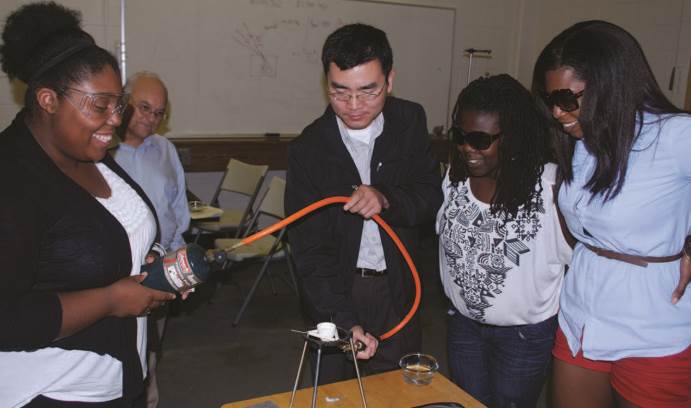Heeding the call of the future

In one outreach program, the IMI-NFG formed a partnership with Tuskegee University to develop a glass engineering curriculum for the historically black institution. MORE
The United States glass industry faced a dim future when NSF established the International Materials Institute for New Functionality in Glass (IMI-NFG) at Lehigh in 2004.
Following the decline of major U.S. industries, like steel, “we saw the writing on the wall,” says Himanshu Jain, director of IMI-NFG. “And we wanted to do something about it.”
Despite 5,000 years of history and major supporting roles in fiber optics, computers, skyscrapers and many other 20th-century technologies, glass had lost its luster as commodity production, and even research, moved overseas.
Education in high-tech glasses, like the bioglass and photonic glasses that Jain specializes in, was also struggling. Americans were authoring fewer research articles, student interest was falling and the number of university glass experts in the U.S. was declining.
“Glass education became fragmented,” says Jain. “One person at a school like Lehigh cannot train a student in an entire technology.”
In response, the IMI-NFG assembled professors from universities across the U.S. and other countries to teach advanced courses to students around the world via Internet. In 2007, the institute connected professors at five universities with 60 learners for a semester-long course using a new teaching paradigm called multi-institution team teaching (MITT).
The IMI-NFG offered several more courses, says Jain, and now holds a library of more than 300 video lectures. “It is the largest video collection for glass education in the world. And it is available anytime, anywhere through the Internet.”
Jain experienced the global reach of the video courses on a trip to Turkey, when engineers at a glass company recognized him on sight from his video appearances.
IMI-NFG also fostered international relationships through a sabbatical program that brought professors from countries including South Korea and Portugal to Lehigh to teach and conduct research. Research exchanges connected graduate students and post-docs from U.S. universities with colleagues from China, Egypt, Italy, Brazil and 25 other nations.
The institute also conducted international glass schools in Japan and China, enabling U.S. students to share classes, industry visits and hotel rooms. The schools sought to build relationships among academics, industry leaders and students who might not otherwise meet, in order to seed future collaboration.
To address the low representation of African-Americans in materials science, Jain launched a partnership with Tuskegee University to bring glass engineering courses to the historically black institution. IMI-NFG also reached out to pre-college educators, training hundreds of teachers to share glass science with younger students—through candy.
“The chemical system of candy—sucrose, water and corn syrup—mimics the window glass system,” Jain says. “Sugar behaves like silica, which is the sand in common glass. Water is analogous to the soda used in glass, and corn syrup acts as aluminum oxide. So here was a way to teach the breadth of glass science in the kitchen.”
William Heffner, IMI-NFG associate director, developed experiments to study glass formation and created a drawing tower that used the principles of cotton candy-making to explain the extrusion of optical fibers.
“We now have an extensive curriculum for middle and high schools,” Jain says. “And I use the same experiments with my Ph.D. students.”
The institute also broke ground in forging industrial partnerships. “The glass field is notorious for secrecy,” Jain says. “This goes back to Roman times. If you leaked out a secret recipe for glassmaking, the punishment was death.
“To develop new functionality it became clear to us that we should work with industry because they are closer to the products and needs of the market,” Jain says. The institute brought together experts from the world’s largest glassmakers and industry representatives—Corning, PPG and GMIC in the U.S.; Schott in Germany; Ashai and Nippon Glass in Japan; and Saint Gobain in France. In 2005, the firms’ chief technology officers sat at the same table for the first time as IMI-NFG’s Industry Board of Advisors.
Industry partners have played a major role in the institute’s final project, a roadmap with promising directions for future research. “We asked industrial leaders and academics to identify the major scientific questions that should be answered so we can come up with better glass,” says Jain.
Though IMI-NFG’s work has wound down, its model for international, multidisciplinary, academy-industry collaboration has become a durable concept. Programs similar to the IMI-NFG have sprung up in Russia, India and the Czech Republic, and a new center in Brazil has been formed at the behest of a member of the institute’s international advisory board.
The decline in U.S. research activity has stopped. “There is still a lot more activity in China than the U.S., but we are better off than we were,” Jain says. “The downward trend has reversed.”
And Corning has stepped up its academic outreach, establishing new programs for academia-industry partnerships. In one such project, two Lehigh graduate students are performing a part of their graduate research at Corning with guidance from its researchers.
“The IMI-NFG legacy is in two directions,” Jain says. “On the educational front, more qualified students are choosing to study glass, and we are seeing the quality of the workforce improve.
“Second, IMI-NFG has helped universities, academia and industry work better together.
“This is the call of the future, and I think we are there now.”
Posted on:



